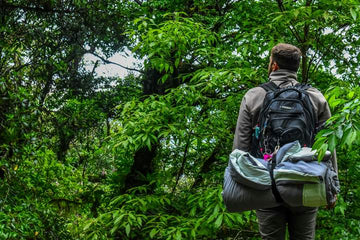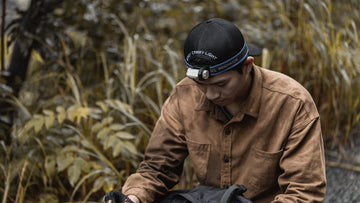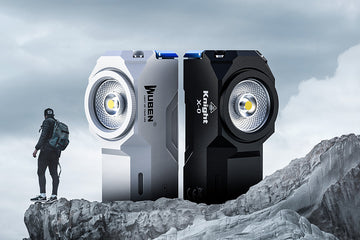
Camping means consciously separating yourself from modern comforts during your vacation.
Camping trips can be about the challenge of pushing your body and will to the limit and finding a deep connection with nature in as few comforts as possible. Or it can simply be about avoiding the distractions that separate us from each other and nature. Disconnecting from the digital and electronic world we spend all day in can be a rewarding experience. Whether it's hiking alone through a mountain range or spending a long weekend at the local campsite, your camping trip will be considerably less comfortable if you forget the essentials.
Below we've compiled our essential camping gear to create the ultimate packing list, from the right sleeping pad to some secret and handy items for more living comfort on the road.
Choosing the right accommodation and sleeping equipment
First of all, choosing the right accommodation and sleeping equipment means you'll be prepared for any weather and have a warm place to rest in the evenings.Tents for shelter are often one of the most expensive camping gear purchases; without them, your trip will be significantly more rustic. When choosing a tent, it's important to remember that the "person rating," e.g. one-person, two-person, etc., only includes the average human body. If you plan on keeping more of your gear inside the tent, like your backpack, go for the next size up. As a rule of thumb, the smaller the tent, the easier it will be to keep warm. Many tents have zippered vents and rain flies to keep you dry or cool depending on the weather. A sturdy zipper is often an overlooked feature of tents; it's better to spend a few dollars more to avoid having your tent zipper break when nature calls.

Inflatable sleeping mats require extra effort to inflate and can leak, resulting in an uncomfortable and often cold position. Inflatable mats can be packed very compactly.
Solid foam mats are often lightweight but take up more space. Mats can be useful in various camping and hiking applications, such as providing an extra layer of cushioning when sitting down, resting, or watching the opposite hills for wildlife.
Sleeping bags come in several designs, the two most popular being the rectangular bag and the mummy bag.
Rectangular bags are easy to use, but are often only intended for warmer weather conditions and lighter operations.
The mummy bag completely envelops the camper and is often made of lighter materials. It can also be purchased with a higher insulation rating for winter or cold camping.
Clothing for different weather conditions
One could fill an entire book, or at least a catalog, with different clothing options when it comes to clothing. Every camper's clothing needs will vary depending on the activity and weather conditions. However, we can offer a few reliable points to consider.First of all, always dress in layers; this allows you to put on an extra layer in case it gets cooler or windier, or reduce layers to reduce the chance of excessive sweating. These layers are important when embarking on a cold weather camping trip where campers may warm up quickly through exercise. For warm or cold weather, synthetic fibers like polyester and nylon offer a great lightweight option and are easily compressible. Unlike cotton, which continues to stay damp with sweat or precipitation, these materials are also considered quick-drying. One caution is that synthetic materials will melt when exposed to high temperatures. Examples of this can be campfires or camp stoves when camping. Melted fabrics not only lose their insulation value, but can also injure the camper, so it's important to remember to keep these fabrics away from the flames. Organic materials like wool or fire-resistant materials like Nomex are our recommendations for working directly with the campfire.
Second, always have a waterproof layer. A set of rain gear or a hardshell jacket is easy to pack when the weather is nice and is worth the time it takes when it starts to rain. Being cold is uncomfortable, but being cold and wet can be dangerous. Waterproof clothing does not stay waterproof forever, each manufacturer will have different care instructions to restore a garment's water resistance. Typically, rewaterproofing clothing involves spraying the item with a product like Durable Water Repellent and throwing it in the dryer. Depending on the garment's use, this can range from once a year to once in a decade.

Last but not least, avoid cotton socks at all costs when camping. They retain moisture, and warm conditions increase the risk of blisters. Cold weather does not insulate the feet sufficiently. Merino wool or synthetic compounds are a much better option. Pack an extra pair to keep your feet dry and warm.

Cooking and food supplies: Must-haves for camping food
Depending on the length and distance of camping, the types of cooking equipment and foods you bring may vary. For example, when car camping , a cooler to keep food from spoiling greatly increases the options available. Items like fresh eggs and chilled meats can make breakfast, lunch and dinner a breeze. To cut down on prep time and increase cooler efficiency, have as many of the meals and ingredients as possible frozen before camping so that those foods stay cold and also keep other foods cold in the process. Sausages or steaks frozen before camping will act as an ice pack, keeping food cold and preventing spoilage without worrying about water levels rising from melting ice.Camping without a cooler requires all foods to be shelf-stable or unrefrigerated. Instant noodles, MREs, and oatmeal are all top choices when backpacking. Two must-have camp meal times are a cast iron skillet and aluminum foil. A cast iron skillet can sit on a grill or directly on a flame and can make anything from pancakes to fried chicken. Aluminum foil only allows campers to steam food inside foil bags, but can also be used as an abrasive cleaner to remove camp grime on the grill. For cutlery, a pocket knife can do most of the prep work, including carving chopsticks from twigs; a spork is still the champion of camping utility. Plus, it takes a lot of work to eat oatmeal with chopsticks.

Essential tools and accessories for outdoor comfort and safety
Camping safety and comfort go hand in hand with any outdoor experience. After sunset, lights are necessary. A headlamp is ideal for most camping tasks because it usually can't be dropped and the beam focuses in the direction you are heading. The headlamp greatly lowers the risk of tripping over rocks, roots, and steaks. A lantern allows light over a larger area; these can sit on the table or hang from a tent pole, allowing campers to light up to eat dinner, get dressed, or read after sunset. Glowsticks or reflective signage are two lightweight items that work well for marking trip hazards and marking a path to and from the campsite. Regardless of size, a shovel should be on your camping gear list. From digging a trench around your tent to digging a cathole when dispersed camping, the ability to move dirt will make your trip much more comfortable. A rescue whistle should be standard on every camper's daypack for added camping safety. The second use or perhaps the reason for having multiple flashlights is the strobe ability of a flashlight to help locate a lost camper, EDC or keychain lights are small, and inexpensive enough that they can be given to any member of the camp.Personal items and hygiene essentials for camping trips
"Roughing it out" while camping may mean skipping a daily shower, but that doesn't mean forgoing all of our hygiene routines. A toothbrush and toothpaste should definitely be brought along, as well as any medications you take daily. These medications can be stored in your first aid kit . Most first aid kits are waterproof and have compartments for extra medicine and tools.Protecting your skin while camping is important no matter the season. Sunscreen should be worn on exposed skin year-round. The sun's rays reflecting off the snow's surface have made many hikers look like raccoons; it's so uncomfortable I'm mentioning it. Use it even if you're hiking through a fog.

Miscellaneous items: Often overlooked but useful for camping comfort
As always, a few practical camping items never fit neatly into the gear list. Most of these items are on the list because they do double duty to repair or improve all kinds of needs around the campsite. One of those items is paracord . Paracord, or 550 cord, is widely available in every color imaginable. I've used it to secure a tent on a windy day, create a pull tab on a broken zipper, and hang my gear in a tree to avoid scavengers. Choosing lighter color cord can also help with marking in the snow or in low light conditions.A pocket hammock can be an excellent addition to the campsite if you are camping in areas with trees. From sleeping under the stars to keeping your gear off the wet ground, the lightweight hammock will have many uses at a campsite.
A portable charger or battery bank is especially handy if you're camping for multiple days. Being able to charge your flashlight, GPS, and cell phone with one unit is a piece of mind that allows you to stay out longer.
Camping is rewarding. There are certainly challenges that come with it, but those challenges are what make camping so exciting. Planning and having the right equipment, from tents and clothing to flashlights and cookware, allows each of us to enjoy the experience of planning and enjoying time outside. Take this list and start your camping checklist; you'll soon be outside and ready to face whatever the campground can throw at you.
Related Articles



